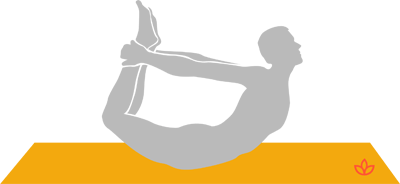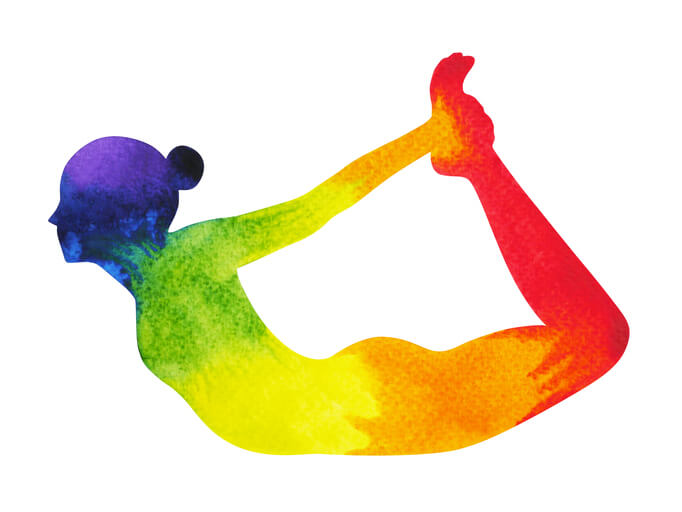Dhanurasana, called bow pose in English, is named for the bow-like shape you form when you practice this powerful backbend. Your arms are the string, while your body and legs form the bow itself.

In reality though, the magic of dhanurasana is more in its felt experience than the way it looks.
Once in the pose, you want to feel poised and full of potential, like an archer’s bow ready to propel its arrow forward. It’s a posture that’s full of promise.
I like to imagine it as a moment when you pause, full of confidence on the brink of action, relishing what is just ahead.
However, your bow pose experience may fall short of this draftl. As with all backbends, may pull to the surface fears or frustrations you didn’t even know were there.
I tend to think of backbends more as front body openers. When we unfurl and open the front aspect of our body, we can end up feeling vulnerable, exposed and resistant.
This, coupled with the fact that your lower belly is pressed into the floor, which can make breathing feel restricted, means this is posture that has the potential to cause anxiety, and even panic. Not what we want.
If your bow pose is an unpleasant experience, you may well be tempted to avoid it all together. But this would be a mistake for a few reasons…
Why You Should Try Bow Pose
Firstly, if every time in yoga we encounter an experience which is uncomfortable or challenging, we avoid it, we’re missing a valuable opportunity to learn and grow.
It’s an “annoying but true” yoga cliché that the postures we like the least are often those that have the most to teach us.
As an example, if I spend most of my life sat at a desk, with my shoulders rounded and my upper back hunched, chances are the first time I try a backbend, it’s going to feel alien, maybe even uncomfortable.
Does this mean I shouldn’t do it? Absolutely not.
Does it mean I should explore the posture with an extra dose of awareness, giving myself longer to feel each sensation and let my body open up in its own time? Yes it does.
Read: Invite More Love Into Your Life With These 5 Heart-Opening Asanas
Secondly, dhanurasana is a posture with a whole host of benefits. It opens up the chest, which can help breathing to feel more expansive, it strengthens the legs and the muscles in the back of the body, and it reverses the postural effects of lots of sitting.
Dhanurasana is also a great energizer, helping to ease fatigue and leave you feeling more confident and inspired. Some even say it helps to relieve period pain.

So if your dhanurasana isn’t quite where you want it to be, here are my five top tips to find the bow pose that’s perfect for you.
1. Choose Your Moment
For most people, bow pose is not one to try first thing in the morning when you’ve just crawled out of bed. Far better to practice bow pose in the second half of your yoga practice, once your body is warmed up and your muscles have found some ease and flexibility.
Try it as part of a sequence of backbends, for example after bridge pose, extended puppy pose and locust pose. This can make all the difference with overcoming both physical and mental resistance.

Read: 5 Gorgeous Yoga Poses and What You Can Learn From Them
2. Use Your Props
I firmly believe that judicious use of props is something no yogi should shy away from in their pursuit of fulfilling, powerful asana experiences.
Start with the basics:
- If you find your hips or pubic bone dig into the ground, place a folded blanket over your mat for extra padding.
- If you struggle to reach your ankles without over-straining the front of your shoulders, loop a belt around them.
- If you can’t stop your knees from splaying wider than your hips in the posture, loop a belt to secure your thighs at hip width apart while you build up the strength and body awareness to hold them here yourself.
3. Maintain Healthy Alignment
As you come into the posture, press your pubic bone down and encourage your tailbone to lengthen down towards the floor. Keep this intention and engagement as you come into the posture, with inner thighs drawing in towards one another to allow for space in the lower back.
Some teachers will cue to keep the legs glued together, but this can feel especially challenging if you are new to the posture, so working with knees hip-width apart can be a more accessible way in.
Let the lift come from the strength of your legs, pressing your feet back and up to allow the front body to open. Keep your shoulders relaxed and your jaw unclenched.
Read: 7 Simple Principles to Fix Many, if not Most, Common Asana Mistakes
4. Allow Your Breathing to Adapt
One of the things that can make dhanurasana feel uncomfortable is trying to force deep, belly breaths in a posture which does not support that. Allow the breath to move more into the upper chest as this posture encourages it to and let it become slightly shallower, if necessary.
Focusing on softness and ease in the chest space can help encourage a more soothing breath here.
5. Take it Slowly
You may only initially be able to hold the posture for a few breaths, but even with a shorter hold, take your time coming into and out of the pose. Over time, you can build up to a 20 or 30 second hold.
When you come out of it, do it with control, resisting any temptation to just let go and slingshot your way out of it. Remember that bow posture is a position of poise and potential energy. As you leave it, you don’t want to throw that all energy away, but rather to allow it to settle back into your own body.
Enjoy some time after the posture lying face down on your belly in stillness, letting yourself simmer in and soak up the after effects of the pose.
Read: 4 True Purposes for Why We Practice Yoga Asana
Finally, the most important thing to remember with dhanurasana is to take the pressure off yourself. Explore the posture with an attitude of openness and curiosity, letting your bow open up in its own time.
There is no rush.
During These Times of Stress and Uncertainty Your Doshas May Be Unbalanced.
To help you bring attention to your doshas and to identify what your predominant dosha is, we created the following quiz.
Try not to stress over every question, but simply answer based off your intuition. After all, you know yourself better than anyone else.